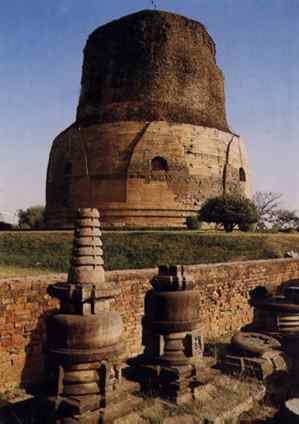Trailing the footsteps of Buddha’s disciples
by Tarannum Manjul, Lucknow Newsline, June 14, 2006
State Archaeology Dept to undertake 6-month tour of countries that Buddha's disciples visited after Sarnath Tour
Lucknow, India -- The country may be busy celebrating the 2550th year of Buddha’s Mahanirvan. But grey areas abound on how Buddhism spread across the globe after Buddha’s first sermon at Sarnath.
 << Sarnath, where the seed of Dharma propagation was first sown
<< Sarnath, where the seed of Dharma propagation was first sown
Which is why, the state’s archeology department has finally decided to track the route taken by Buddha’s disciples—Kumar Jeev, Kashyap and Matang— to spread his message of peace and harmony. The department will not only follow the land route, but also document the spots that retain their footsteps.
The project, titled “The Buddha Sandesh Yatra”, will span 11 countries. Beginning from Sarnath, the team will travel to Burma, Thailand, Malaysia, Cambodia, Vietnam, China, Pakistan, Uzbekistan, Afganistan, Pakistan and Tibet.
“We have managed to prepare a map. And we even have a tentative route ready in case there is a problem with Route 1,” said Dr Rakesh Tiwari, director of UP State Archaeology Department (SAD).
Dr Tiwari, who has conceptualised the project, said: “Whatever we know about Buddhism’s reach and the trade and cultural relations it facilitated, is through the accounts of travellers like Fa Hein and Huen Tsang. But how many of us are aware that after the first sermon at Sarnath, several of Buddha’s disciples, which included prime disciples like Kumar Jeev, Matang and Kashyap, went across the world following his instructions to spread the message of peace. After his first sermon, Buddha told his disciples ‘Charak Bhikhave Charakam’ which means that all the monks should now reach out. It is ironical that there are no documented evidence of this route. But we will have to find out the spread,” Dr Tiwari said.
The team will also interact with university teachers and researchers of the countries to and look for publications on Buddhist sites and culture brought out there.
“There are several important sites like Bamiyan in Afganistan and Taxila, Balkh and Magahar in Pakistan which have to be connected with India culturally,” said Dr Tiwari.
In course of the journey, the team will also try to promote cultural ties using the message of Buddha. “There are evidences of wonderful cultural relations with countries like Swarndeep (Burma), Cambu Desh (Cambodia) and Champa Desh (Vietnam) in ancient India and we want to rekindle the flame of relationship with these countries,” he said.
The 12-member archeologists’ team will capture the highlights of their journey on film. “We still do not have much information about many sites and this project will be the first attempt to document them not only in writing, but also on film,” Dr Tiwari said.
The entire project is expected to cost around Rs 1.25 crore and will take at least five to six months to complete.
“We have already submitted the proposal to the state government for the funds. The project, if completed within the celebration year of 2550th year of Mahaparinirvan, will be an eye opener in more ways than one,” he added.

 << Sarnath, where the seed of Dharma propagation was first sown
<< Sarnath, where the seed of Dharma propagation was first sown